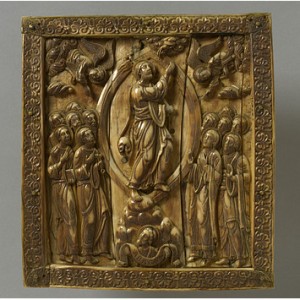The October 22, 2010, issue of the TLS, alas not available genreally, has a fine review of a book by Paul Williamson, Medieval Ivory Carvings: Early Christianity to Romanesque, which describes the collection held at the Victoria and Albert Museum in London. Some paragraphs of the review that struck me:
A single plaque rarely measures more than 20 cm by 15 cm; which meant that, when there was a lot to fit in, an intricate scene might need to be carved in a square whose sides were no longer than a thumb. One twelfth-century English liturgical comb, 11 cm across, carries no fewer than twelve gospel scenes,all decipherable.... Among medieval artistic media it was the microchip.
The skill ivory required of its carver, added to the market value of his material, made a product expensive. So it was all the more important to get the imagery right. Even in this one collection we sense the constancy of artists efforts to ensure this. Christian imagery called for two kinds of imagination, corresponding to the two natures that theologians [sic!] attributed to Christ. Christs human nature demanded a purely visual imagination. This is nowhere better illustrated than in the Nativity, the traditional ingredients of which could be rearranged and augmented from direct or indirect real-life observation. An eleventh-century Cologne Nativity shows the Virgins shoes neatly placed on a stool beside her bed. A twelfth-century panel, possibly from Outremer, has the Christ child being washed in a tub. This kind of imaginative detail could also extend before and after the Nativity itself. An annunciation panel made in central Italy around 1200 adds a handmaid, peeping from behind a curtain at Marys meeting with the angel. One Carolingian plaque shows post-Nativity scenes with particularly arresting vividness: Herods soldiers dash babies to the ground like blacksmiths hammering at their anvils, while in the neighboring panel, a bare-breasted mother flings out her arms as if on Gricaults "Raft of the Medusa," in anguish at her childs deathall this in a frame less than 5 cm. across.
I have always thought that attention to Christian art and popular piety would go far toward disproving the common view that for most of Christian history such emphasis was placed on the divinity of Christ that his full humanity was overlooked.
Spirit has no dimensions, so its depiction is harder for artists the more dimensions they work in: harder, that is, in three dimensions than in two, from which plane ivory sculptures happily inherited a repertoire of recognized symbols. Even in solid ivory, the holy have haloes and angels have wings (often haloes too). As to Christ himself, he wears a halo when immersed in human society, but in gospel episodes where his divinity appears at its purest, his supreme rank of spirituality is denoted by the lozenge-shaped super-halo, framing his whole figure, known as the mandorla...Symbols easily become clichs. The more conscious an artist was of the reality behind the symbol, the more restlessly he would attempt to express in his own way, each attempt ncessarily a failure, but a different one. This originality is detectable in a French Ascension plaque made around 1160-70, a time when sculptors at Chartres were making similar attempts in stone. The Ascension plaque in question drops the mandorla, and also the traditional Ascension image of Christ as rising vertically, as in a lift or a rocket. Instead, Christ climbs through the air as if on a ladder, one leg high above the other, while his Fathers hand (usually just pointing down from a cloud to show he is there) reaches down to grasp his Son by the wrist, to pull him back home to heaven.
 You and can see some of the Vand As collection hereand here.
You and can see some of the Vand As collection hereand here.
Please email comments to [email protected] and join the conversation on our Facebook page.
Share
Previous Story
Forgotten password
Next Story
Sisterhood
